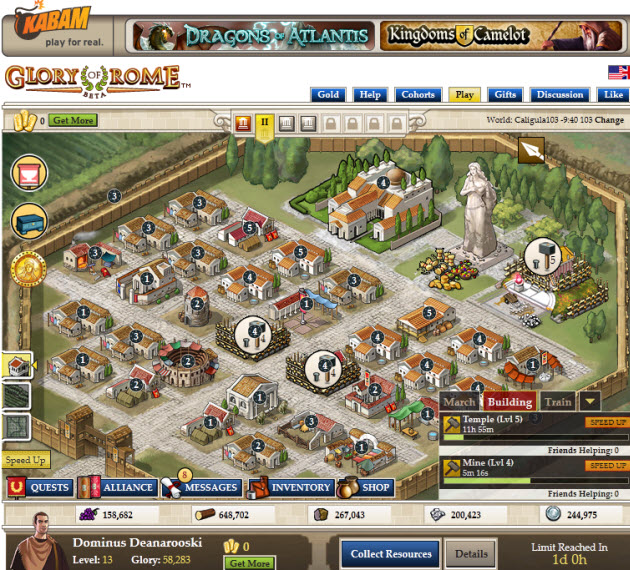 I’ve been playing Kabam‘s Glory of Rome social game on Facebook for a few weeks. Based on that experience, I can see that Kabam has begun to crack the code for creating entertaining games for the emerging and very lucrative hardcore audience on Facebook.
I’ve been playing Kabam‘s Glory of Rome social game on Facebook for a few weeks. Based on that experience, I can see that Kabam has begun to crack the code for creating entertaining games for the emerging and very lucrative hardcore audience on Facebook.
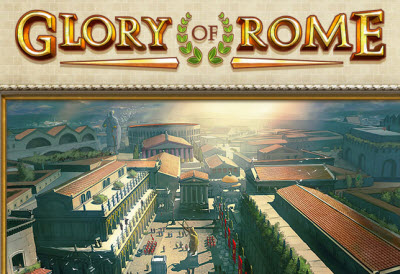 Glory of Rome is an interesting game because it is an example of how Kabam is winning the land grab for hardcore users on the social network. While Zynga has a lock on hundreds of millions of casual gamers, Kabam has a mere 6.7 million Facebook users. But those users are far more valuable because they are willing to pay Kabam a lot. The game is one of three active Kabam games on Facebook, in addition to its predecessor Kingdoms of Camelot and the newer Dragons of Atlantis.
Glory of Rome is an interesting game because it is an example of how Kabam is winning the land grab for hardcore users on the social network. While Zynga has a lock on hundreds of millions of casual gamers, Kabam has a mere 6.7 million Facebook users. But those users are far more valuable because they are willing to pay Kabam a lot. The game is one of three active Kabam games on Facebook, in addition to its predecessor Kingdoms of Camelot and the newer Dragons of Atlantis.
Why Kabam is on the right track
Kabam is a private company and doesn’t disclose revenue per user. But the tea leaves suggest that, just a stone’s throw away from the headquarters of traditional game company Electronic Arts, Kabam is building a very large business that could disrupt other game makers. Based on its anti-Zynga strategy, Kabam was able to raise a $30 million round earlier this year and is rumored to be raising another round at a higher value because of the value of its users. And Kabam has more than 400 employees now.
“We are going after Activision Blizzard and Electronic Arts head on,” said Kevin Chou, chief executive of Redwood City, Calif.-based Kabam, in an interview. “That’s a big audacious statement. But you will see more coming from us soon that will back that up. We think this is a big opportunity and we are investing heavily in it.”
That is a crazy statement in some respects. Four years ago, when Kabam started, there was no market for hardcore games on Facebook. But Kabam is riding the rise of the free-to-play business model, where users can play games for free on Facebook and pay real money for virtual goods such as construction speed-ups for city buildings. If Kabam charged these gamers $60 for a game, it would actually be charging them too little. By switching to its games as a service model, Kabam can continuously generate more revenues from gamers who gladly pay lots of money each month.
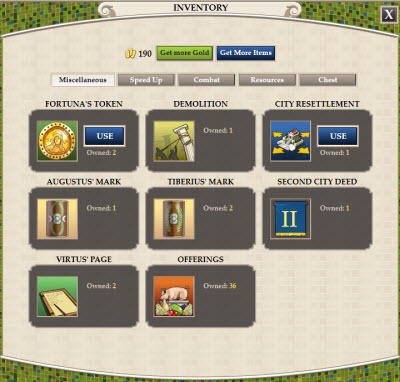 While Zynga gets a few bucks out of a few percent of users, Kabam gets more. Everybody in the game industry woke up to the Kabam-style model of getting more dollars out of hardcore gamers when China’s Tencent bought the majority of Riot Games for nearly $400 million in February. Riot Games had only 1 million users playing one game, but those dedicated gamers spent a lot of money. EA, for its part, has its own online role-playing game Lord of Ultima online on Bigpoint.com.
While Zynga gets a few bucks out of a few percent of users, Kabam gets more. Everybody in the game industry woke up to the Kabam-style model of getting more dollars out of hardcore gamers when China’s Tencent bought the majority of Riot Games for nearly $400 million in February. Riot Games had only 1 million users playing one game, but those dedicated gamers spent a lot of money. EA, for its part, has its own online role-playing game Lord of Ultima online on Bigpoint.com.
There’s an opening for Kabam to get big in this niche because many of the big traditional game publishers have left the PC game market to focus on the consoles. And the traditional game publishers who have entered the Facebook market are focusing on competing with Zynga for the new demographic of casual gamers on Facebook. No one is really competing directly with Kabam, except other startups such as Kixeye.
Glory of Rome only has about 1.5 million users, but they’re dedicated. (I’d rate the game about 85 out of 100 as a game reviewer.) Chou said that 90 percent of his company’s users log into their games six or seven days a week. They play the game for about 4 hours at a time. That sounds insane, but a great deal of the time spent in the game is constructing the different buildings in your city. As you can see from the map, you build up a single city at the start, with attractive-looking, realistic buildings.
At first, this takes a short time, but it takes longer and longer to build something as you raise the levels of your villas, farms, mines, quarries, sawmills and special buildings. So you can play the game by issuing a few commands and then leaving it running in a browser in the background while you do your work or cruise the web. The ability to multitask while you’re playing this game makes it ideal for hardcore gamers who don’t really have a lot of time to play.
 In Kabam games, the movement and actions are in real time, or simultaneous play. Thousands of gamers interact at the same time, and as many as 100 can join a multiplayer alliance to compete with other alliances across a grid of cities, mountains, forests, grasslands, hills and rivers.
In Kabam games, the movement and actions are in real time, or simultaneous play. Thousands of gamers interact at the same time, and as many as 100 can join a multiplayer alliance to compete with other alliances across a grid of cities, mountains, forests, grasslands, hills and rivers.
Glory of Rome is modeled after Kabam’s first big hit, Kingdoms of Camelot, which bears resemblance to titles such as Evony and Civilization. With each new simulation strategy game, Kabam is progressing up the food chain and getting better at what it does.
At some point, Kabam could hit a wall on Facebook. The social network isn’t really built to support outstanding console-style graphics and real-time game play. Kabam does what it can on these parts of its games, offering still animated screens rather than moving animations. And it has built a sophisticated back-end infrastructure capable of synchronizing all of the moves that players are making without inordinate delays. Consequently, Kabam has higher server costs because it has to build a responsive game.
Over time, the social network platform will become better at running online games. For now, Kabam is one of the few lucky companies whose games have consistently struck a chord around the world. Over time, as the Facebook audience embraces variety, the hardcore audience could grow big and Kabam will reap the benefit.
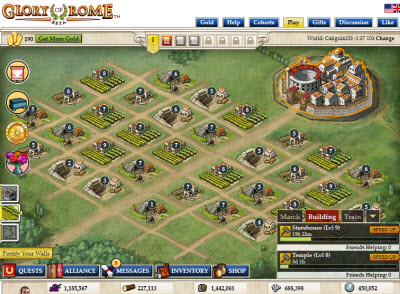 Glory of Rome is a different Facebook experience
Glory of Rome is a different Facebook experience
While Zynga lets you play casual game experiences for maybe ten minutes a day with your Facebook friends, Kabam’s games take advantage of a different kind of friend network based on common interests.
I invited a bunch of my friends to join me in Glory of Rome, but nobody really took me up on it. So I had to make friends on my own by joining a group of strangers that I met in the game. We play together because we met in the game and we like it.
Kabam encourages you to make friends in the game by requiring you to have a certain number of friends in order to build your second city in the game. The trouble with the process now is that you have to ask for someone’s real email and then send them a request to be a friend on Facebook. Then you have to confirm that and send them an invite from within the game.
In contrast to other social games, Kabam’s titles are also real games. While casual games are more laid back, hardcore games are more serious, Chou said. If you make a bad decision in Glory of Rome, the results can be catastrophic. And if you make the right move, it will pay off with brilliant results. At the start of the game, for instance, it’s critical that you pick the right friends to play the game with, since you’ll be spending a lot of time with them.
Keith Kawabata, senior producer on Glory of Rome, says the game stays faithful to a historical representation of Rome, set around 68 AD after the burning of the city. It targets gamers who might otherwise be playing online hardcore games or traditional PC titles. Those gamers have been under-served on the social networks.
As with other strategy games, the challenge of Glory of Rome is to pay attention to the details. And you have to divide your attention across many tasks. You don’t want to spend all of your time creating cool buildings, if it means you neglect training troops. You don’t want to make the city so militaristic that it will bring down the wrath of other players on you. And you have to pay attention to the wider world around you. You don’t want to build your empire in the middle of another rival’s alliance.
What I like about the game is that you are rewarded if you invest your time in the game. That is, you don’t have to put hours into it. But if you check in on the game every few hours, you can help your city grow faster and make more of a contribution to your fellow alliance members. Your actions can make a big difference on the strategic level. You can pay money to speed up construction in the game, but you can also do everything that other players can do without spending a cent.
 A challenge: It isn’t easy being a newbie player in Kabam games
A challenge: It isn’t easy being a newbie player in Kabam games
Kabam has a long way to go to create better hardcores game in some respects. You have to refresh the game periodically because it gives you ridiculous analytics reports sometimes, like saying your production capacity for food is high at a given moment and then lower the next moment.
The help offered for newbies is also very vague. In Kingdoms of Camelot (which was Kabam’s first hit game), I joined the game casually, unaware that I only had seven days to build as powerful a city as I could. By the end of seven days, my newbie “protection” expired. At the moment I became susceptible to attack, I got attacked repeatedly by enemies who stole everything I had. I didn’t realize that I had to build up my walls and expand my storehouse in order to protect my resources from being ripped off. The time I invested in building my resources was wasted. I didn’t realize it because Kabam didn’t hammer this point home to me.
To protect myself, I tried to join an alliance, a group of 100 players. I was rejected several times because I was too small. I was also attacked repeatedly while I was sleeping. My resources dropped so low I couldn’t even build anything to defend myself. It just wasn’t a fun experience to be picked clean by veteran players. Kabam didn’t do enough to teach me how to play and protect myself.
The challenge here is that there are just tons and tons of players, and there are some “griefers,” or people who like to pick on other players, in any crowd of gamers. With Glory of Rome, it is just far too easy for anybody to become a griefer without any negative consequences whatsoever. The nice thing is that you never actually see your city get razed to the ground in the game. And if you are the victim of constant raiding in the game, you can hide your city by playing a city resettlement card.
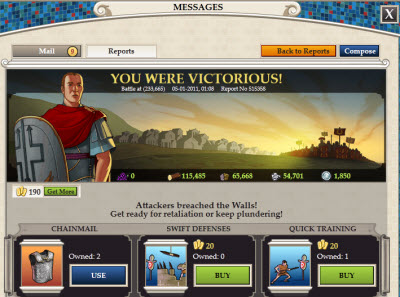 A better experience with Glory of Rome
A better experience with Glory of Rome
With Glory of Rome, I realized I had to build as much as possible during the first seven days to be able to survive in the wild. I concentrated on building my basic resources — farms, quarries, sawmills and mines. Then I added walls to protect my silver and a storehouse to protect my resources from attackers. I kept my troops hidden in the palace so they couldn’t be destroyed during an attack. With this strategy, I was able to grow large enough to sustain my city. And I joined an alliance.
I built my basic resources and had to make sure that the homes I built and the soldiers I trained didn’t exceed my ability to feed new residents or armies. There are some key buildings that you have to create in order to make progress in the game, such as a barracks for training soldiers, walls to protect your treasury, a general’s quarters to house your leaders, and an academy where you research new capabilities. Over time, you start building lots of troops and then upgrade your farms to feed them.
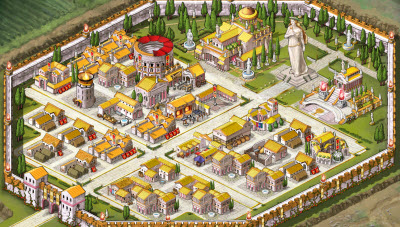 Our alliance has seen a decent amount of drama. Our leader had to bounce a member for talking disrespectfully about the leadership. Then our leader came under constant attack from one of the rival clans. He defended himself well for a full day, but his city was a big target and the enemy kept hitting him. He eventually gave up and abdicated. Then he joined one of the top five clans to get their protection from further attacks. One of our members then jumped ship and joined the clan that had been attacking us. That was completely treacherous behavior and it probably leaked a fair amount of our secrets to the other group.
Our alliance has seen a decent amount of drama. Our leader had to bounce a member for talking disrespectfully about the leadership. Then our leader came under constant attack from one of the rival clans. He defended himself well for a full day, but his city was a big target and the enemy kept hitting him. He eventually gave up and abdicated. Then he joined one of the top five clans to get their protection from further attacks. One of our members then jumped ship and joined the clan that had been attacking us. That was completely treacherous behavior and it probably leaked a fair amount of our secrets to the other group.
Our new ruler took over and tried to patch things up. He appointed one of our members to concentrate on creating more friendly alliances with other clans. Her success got her a promotion to vice chancellor. She eventually made peace with the rival. In the meantime, most of us kept growing our cities and armies.
Of 77 members, I have the 11th-largest amount of Glory, and our collective rank is 27. We’re friendly with almost all of the clans except for one. I have been attacking a bunch of the small neutral cities in my area, a process known as “farming” for resources. First you scout the rival (which costs you silver) and then you attack it. If the rival hasn’t properly hidden or protected his or her resources, you can defeat the defenders in battle and then loot the unprotected resources. I have had no problem finding unprotected neutral cities with lots of resources to raid. To me, that means that Kabam doesn’t do a good enough job telling players how to protect themselves.
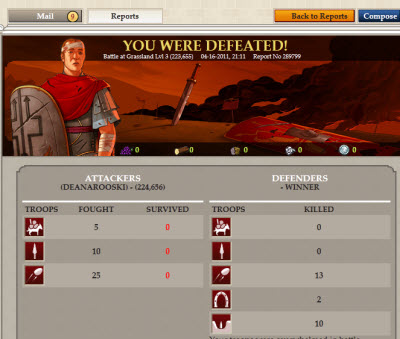 I made a couple of mistakes along the way, attacking areas of the map known as “wilds.” These are places like hills or mountains that have resources which can be farmed and are occupied by barbarians. Both times, I lost about 5,000 or 6,000 soldiers, mainly because I attacked with a force that wasn’t large enough to beat the entrenched enemy.
I made a couple of mistakes along the way, attacking areas of the map known as “wilds.” These are places like hills or mountains that have resources which can be farmed and are occupied by barbarians. Both times, I lost about 5,000 or 6,000 soldiers, mainly because I attacked with a force that wasn’t large enough to beat the entrenched enemy.
The combat is kind of fun because you have to wait in anticipation for the result as your troops march to the location and then march back. You get a report back that says whether you won or lost and what resources you gained. I lost because I truly didn’t know what kind of superior force I needed to win. I thought my soldiers and my accompanying general (you appoint your friends as generals) were trained enough to beat the barbarians. But I lost and I felt stupid and at a loss to understand why the combat didn’t work out. Kawabata at Kabam says the explanation of combat could be better (in fact, nothing comes up when you search the “help” area on the word “combat.”). In the future, the company will include more tutorial information and better explanations of how combat works.
Have I spent any money in the game? Yes and no. I didn’t buy anything with a credit card or Facebook Credits, which is Facebook’s virtual currency. Rather, I accepted a special offer as an alternative payment system. I bought FTD flowers for my wife on Mother’s Day, which yielded about 190 in gold currency for the game. That’s a little less than $20. Kabam gets a cut of that money, and so I’m sure it will be happy to know that I’ve been “converted” from a non-paying user to a paying user. However, so far, I am making a lot less money for Kabam than a usual paying user.
 Conclusion: Pay attention to Kabam
Conclusion: Pay attention to Kabam
I’ve had a look at some of Kabam’s games coming down the road. And I have to tell you that they are getting better and better at what they do. Kabam has built up its staff so big that it will soon have a steady number of games coming through its pipeline.
This game has consumed a lot of my time and I don’t regret it. In fact, I’ve been playing this game far more than I have Zynga’s games such as CityVille and FarmVille.
Kabam has to be careful to walk a delicate line. It can’t race too far ahead of Facebook, which is kind of a weak platform for hardcore games. You can’t build a console-like game for the social network and expect it to run fast. Kabam also has to make sure that its games are satisfying for hardcore gamers who like extreme challenges. But it has to make the games accessible enough so they are easy for lots of hardcore gamers to learn. It doesn’t want to create a game that is so hard to play that only a few thousand people take the time to play it.
In summary, I have to say that Kabam is building a compelling market position with games like Glory of Rome. The company has some great things going for it and it has a lot of hardcore fans. It doesn’t have big brands such as Take-Two Interactive and Firaxis Games’ Civilization brand. In fact, a rival Civilization game will hit the market at some point. But for now, Kabam has a chance to create its own brands while traditional game publishers play catch-up on Facebook.
VentureBeat's mission is to be a digital town square for technical decision-makers to gain knowledge about transformative enterprise technology and transact. Learn More
